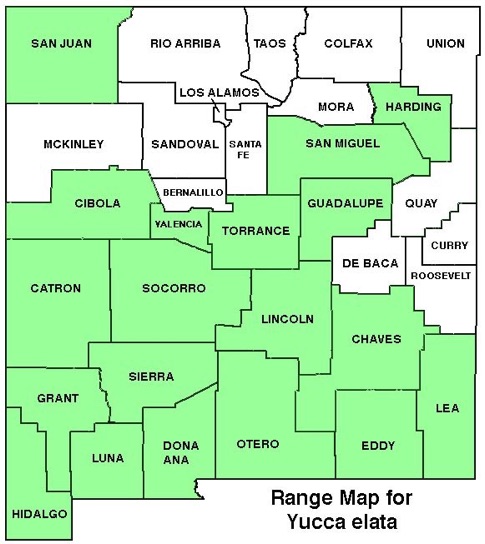WILDFLOWERS OF NEW MEXICO

This handsome tree yucca has a 3–15-foot tall trunk, often with multiple branches, each with a head or rosette of slender, spine-tipped leaves lined with scattered, fine threads. Note the 3–6-foot tall bloom stalk, even in young plants without trunks.
FLOWER: May–July. Creamy-white flowers, egg-shaped and 1 1/4–2 1/4-inches long (3–5.7 cm), grow in a dense spike-like cluster (panicle) with short branchlets on a stalk that extends to 6-feet above the leaves. The tall, branching flower stalk distinguishes even young, stemless rosettes. The erect, not hanging, fruit matures into an oblong, capsule 1 1/2–3 1/4-inches long (3.8–8.2 cm) with chambers filled with flat, black seeds. The capsule splits open when dry.
LEAVES: Stem rosette on branch ends. Leaves, 10–35 1/2-inches long, 1/8–1/2-inch wide (3–12 mm) at mid-length and with a spiny tip; blades flexible with entire to slightly saw-toothed margins lined with scattered, fine threads, especially near the base.
HABITAT: Dry rocky, sandy soils of hills, mesas; desert grasslands and scrub, pinyon-juniper woodlands.
ELEVATION: 3,400–6,300 feet.
RANGE: AZ, CA, NM, TX.
SIMILAR SPECIES: Trecul Yucca, Y. treculeana, and other tree yuccas in so. NM, have broad, stout, unbending leaves.
NM COUNTUES: In the so. half of NM and scattered elsewhere in low-elevation, arid habitats: Cibola, Catron, Chaves, Dona Ana, Eddy, Grant, Guadalupe, Harding, Hidalgo, Lea, Lincoln, Luna, Otero, San Juan, San Miguel, Sierra, Socorro, Torrance, Valencia.
NOTES: Native Americans boiled the flowers to eat, roasted the young, tender stems, pit cooked and trunks, wove the leaves into baskets, and used the fibers for cordage.
NOTES: Yuccas and the moths that pollinate them are totally dependent on each other, often with one species or variety of moth dedicated to a single species of yucca. The small, white moth gathers a ball of pollen and at the next flower stuffs it in the specially designed stigma. She then lays eggs in the pollinated ovary so the larva can feed on the developing seeds. The larvae emerge, leaving numerous undamaged seeds, and pupate in the ground. Flowers unfertilized by the moth don’t form capsules. The petals drop leaving the bare flower stem on the dead stalk.

SOAPTREE YUCCA
YUCCA ELATA
Asparagus Family, Asparagaceae (formerly in Agave Family, Agavaceae)
Perennial shrub



THE CONTENTS OF THIS WEBSITE ARE COPYRIGHTED AND CANNOT BE USED
WITHOUT PERMISSION OF GEORGE OXFORD MILLER



Yucca elata has a tall bloom stalk that elevates the flower cluster 3–6 feet above the leaves.
The flower cluster has numerous small branchlets (panicle).
Dense rosettes on trunk branches have flexible, narrow leaves only 1/2-inch wide.
The ornate Yucca elata is a popular landscape plant throughout the Southwest.
Possible record Yucca elata at White Sands Missile Range is 30.73 feet tall (9.37 m).

EMAIL ME